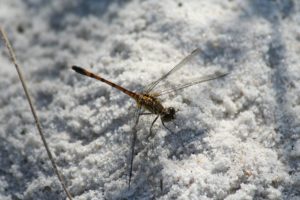Here in the Northern part of the US, the blustery winds of winter are well upon us. The cold climate forces us to bundle up in warm layers clothes if we choose to brave the frozen world outside our well-heated, insulated homes. With so much of our response to the cold being behavioral, the question may arise as to how other animals endure the harshest time of the year. Some of us may be familiar with the hibernation of other mammals, but how do the creatures that don’t produce their own body heat (ectotherms) manage to survive? Insects have the additional concern of losing heat rapidly due to their diminutive size and small surface area. Most insects, much like members of the plant kingdom, have to survive while remaining in thermal equilibrium with the frozen world outside.
Insects have adapted to the ravages of winter in much the same way they succeed in so many other circumstances. Unlike the behavioral adaptations of humans, insects thrive in a range of ecological situations through the sheer variety of habitats they occupy. Almost one million species have been described, each populating a specific set of conditions and limitations. Species adapt further into specialist niches, which allows for greater diversity.
Considering their immense variety of forms, it shouldn’t surprise us that these fascinating animals have evolved many techniques to avoid the harsh climate of winter. While some insects seek shelter under the thick layers of snow and avoid the freezing temperatures above, others are able to endure being frozen entirely. Very few migrate to avoid the cold, mostly due to their short lifespan. There is no best way to handle climatic extremes, as each strategy evolved under a different set of restrictions and opportunities.

A common threat in cold climates to all members of the class Insecta is the danger of freezing in living tissues. Ice formation presents many hardships to biological systems, some more obvious than others. While the expanding nature of water molecules rupturing cell tissues may be apparent, even mechanisms that exclude ice to outside the cell can wreak havoc on cellular function. Highly concentrated solutes in extracellular ice can disrupt concentration gradients and force dehydration of tissue as well as distorting intercellular signaling. This severing of cellular communication requires that every cell function on its own during exposure to freezing temperatures. That’s a pretty scary prospect for a creature housing billions of cells in different kinds of tissues!
One of the strategies that insects (and other small animals and some plants) employ to survive harsh exposure is that of freeze avoidance. These creatures cannot withstand ice formation in the body and must develop an advanced strategy to avoid freezing. This is primarily done through a process known as supercooling, in which the freezing point of a substance in pushed below normal, allowing animals and plants that employ this technique to survive temperatures as low as -40˚F. Supercooling can be achieved in several ways, either by preventing the seeding of ice crystals or manipulating the freezing point of water in tissues. The goldenrod gall moth larva (Epiblema scudderiana) encourages supercooling by reducing its body-water content from 60% to 25% of total larval weight. The water does not leave the body of the larva, but is rather used to convert stored glycogen to glycerol (an antifreeze molecule) and also incorporated into macromolecular structures. Both the reduction of free water and the hydrolysis of glycogen to glycerol allow the larva to exist in an ice-free state well below freezing outside temperatures.

A problem arises, however, for the supercooled insect in that water is only stable as a solid below its freezing point. Any disruption to the tenuous balance of internal chemical levels can result in flash freezing and death. A way to avoid this is to promote earlier and more gradual freezing within tissues, relegating ice formation to extracellular areas and mitigating the disruption of intercellular communication. Insects that employ this strategy are called freeze-tolerant. This process begins with the production of molecules that act to promote the formation of ice within the body, sometimes at temperatures above freezing. This is believed to occur by sites that allow ice to adsorb onto the surface of molecules, thereby allowing subsequent ice-lattice formation to proceed rapidly. By encouraging this early freezing at a reduced rate, the insects are able to minimize stress to their systems and allow more time for cellular adjustment. Anitfreeze proteins then act to reduce the amount of further ice formation and stabilize other proteins within the cell. While there is a good deal of overlap with these strategies, neither is exclusively better than the other. Both processes are employed by some insects, such as the beetle larva of Pytho deplanatus, which produces large amounts of glycerol and supercools to -54 C while still being tolerant of freezing.

It should be no surprise that a group as varied as the insects has developed such an array of sophisticated responses to surviving some of the worlds harshest climates. There are still so many mysteries to uncover on how these tiniest creatures deal with big problems of winter survival!




